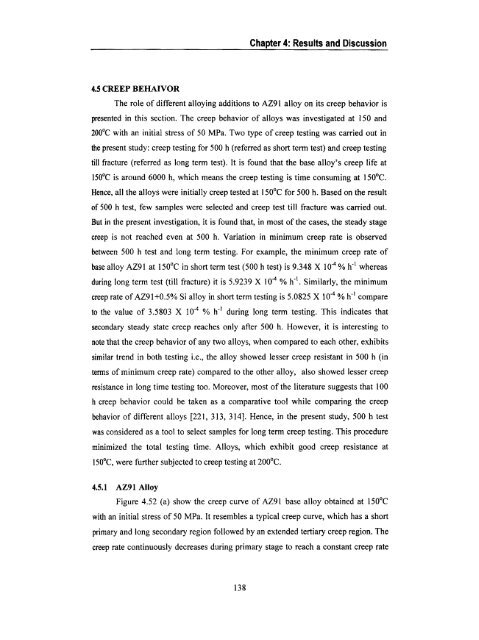“Influence of Si, Sb and Sr Additions on the Microstructure ...
“Influence of Si, Sb and Sr Additions on the Microstructure ...
“Influence of Si, Sb and Sr Additions on the Microstructure ...
Create successful ePaper yourself
Turn your PDF publications into a flip-book with our unique Google optimized e-Paper software.
4.5 CREEP BEHAIVOR<br />
i g Chapter 4: Results <str<strong>on</strong>g>and</str<strong>on</strong>g>Discussi<strong>on</strong><br />
The role <str<strong>on</strong>g>of</str<strong>on</strong>g> different alloying additi<strong>on</strong>s to AZ91 alloy <strong>on</strong> its creep behavior is<br />
presented in this secti<strong>on</strong>. The creep behavior <str<strong>on</strong>g>of</str<strong>on</strong>g> alloys was investigated at 150 <str<strong>on</strong>g>and</str<strong>on</strong>g><br />
200°C with an initial stress <str<strong>on</strong>g>of</str<strong>on</strong>g> 50 MPa. Two type <str<strong>on</strong>g>of</str<strong>on</strong>g> creep testing was carried out in<br />
<strong>the</strong> present study: creep testing for 500 h (referred as short term test) <str<strong>on</strong>g>and</str<strong>on</strong>g> creep testing<br />
till fracture (referred as l<strong>on</strong>g term test). It is found that <strong>the</strong> base alloy’s creep life at<br />
150°C is around 6000 h, which means <strong>the</strong> creep testing is time c<strong>on</strong>suming at 150°C.<br />
Hence, all <strong>the</strong> alloys were initially creep tested at 150°C for 500 h. Based <strong>on</strong> <strong>the</strong> result<br />
<str<strong>on</strong>g>of</str<strong>on</strong>g> 500 h test, few samples were selected <str<strong>on</strong>g>and</str<strong>on</strong>g> creep test till fracture was carried out.<br />
But in <strong>the</strong> present investigati<strong>on</strong>, it is found that, in most <str<strong>on</strong>g>of</str<strong>on</strong>g> <strong>the</strong> cases, <strong>the</strong> steady stage<br />
creep is not reached even at 500 h. Variati<strong>on</strong> in minimum creep rate is observed<br />
between 500 h test <str<strong>on</strong>g>and</str<strong>on</strong>g> l<strong>on</strong>g term testing. For example, <strong>the</strong> minimum creep rate <str<strong>on</strong>g>of</str<strong>on</strong>g><br />
base alloy AZ91 at 150°C in short term test (500 h test) is 9.348 x 10*‘ % h" whereas<br />
during l<strong>on</strong>g term test (till fracture) it is 5.9239 X 104 % h". <str<strong>on</strong>g>Si</str<strong>on</strong>g>milarly, <strong>the</strong> minimum<br />
creep rate <str<strong>on</strong>g>of</str<strong>on</strong>g> AZ9l+0.5% <str<strong>on</strong>g>Si</str<strong>on</strong>g> alloy in short term testing is 5.0825 X 10'4 % h" compare<br />
to <strong>the</strong> value <str<strong>on</strong>g>of</str<strong>on</strong>g> 3.5803 X 10"“ % h" during l<strong>on</strong>g term testing. This indicates that<br />
sec<strong>on</strong>dary steady state creep reaches <strong>on</strong>ly after 500 h. However, it is interesting to<br />
note that <strong>the</strong> creep behavior <str<strong>on</strong>g>of</str<strong>on</strong>g> any two alloys, when compared to each o<strong>the</strong>r, exhibits<br />
similar trend in both testing i.e., <strong>the</strong> alloy showed lesser creep resistant in 500 h (in<br />
terms <str<strong>on</strong>g>of</str<strong>on</strong>g> minimum creep rate) compared to <strong>the</strong> o<strong>the</strong>r alloy, also showed lesser creep<br />
resistance in l<strong>on</strong>g time testing too. Moreover, most <str<strong>on</strong>g>of</str<strong>on</strong>g> <strong>the</strong> literature suggests that 100<br />
h creep behavior could be taken as a comparative tool while comparing <strong>the</strong> creep<br />
behavior <str<strong>on</strong>g>of</str<strong>on</strong>g> different alloys [22], 313, 314]. Hence, in <strong>the</strong> present study, 500 h test<br />
was c<strong>on</strong>sidered as a tool to select samples for l<strong>on</strong>g term creep testing. This procedure<br />
minimized <strong>the</strong> total testing time. Alloys, which exhibit good creep resistance at<br />
150°C, were fur<strong>the</strong>r subjected to creep testing at 200°C.<br />
4.5.1 AZ91 Alloy<br />
Figure 4.52 (a) show <strong>the</strong> creep curve <str<strong>on</strong>g>of</str<strong>on</strong>g> AZ91 base alloy obtained at 150°C<br />
with an initial stress <str<strong>on</strong>g>of</str<strong>on</strong>g> 50 MPa. It resembles a typical creep curve, which has a short<br />
primary <str<strong>on</strong>g>and</str<strong>on</strong>g> l<strong>on</strong>g sec<strong>on</strong>dary regi<strong>on</strong> followed by an extended tertiary creep regi<strong>on</strong>. The<br />
creep rate c<strong>on</strong>tinuously decreases during primary stage to reach a c<strong>on</strong>stant creep rate<br />
138
















